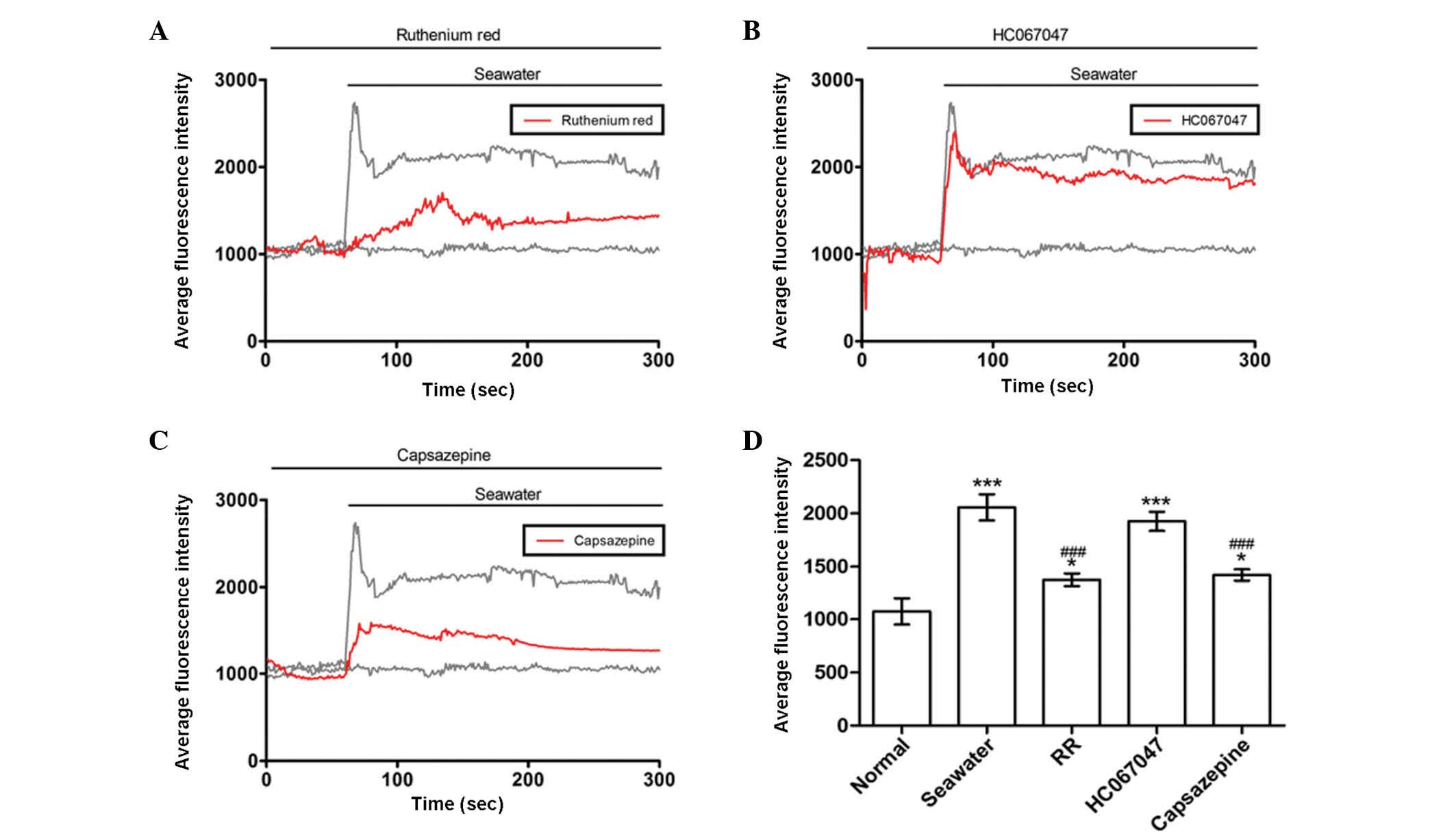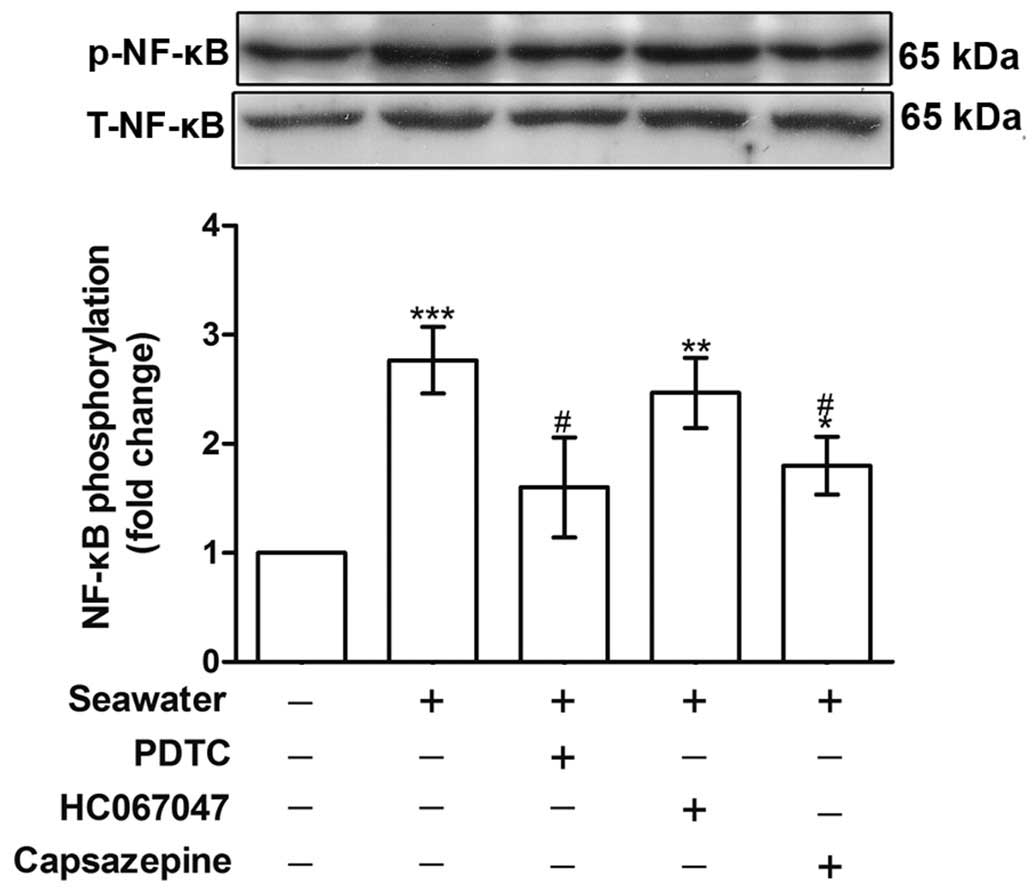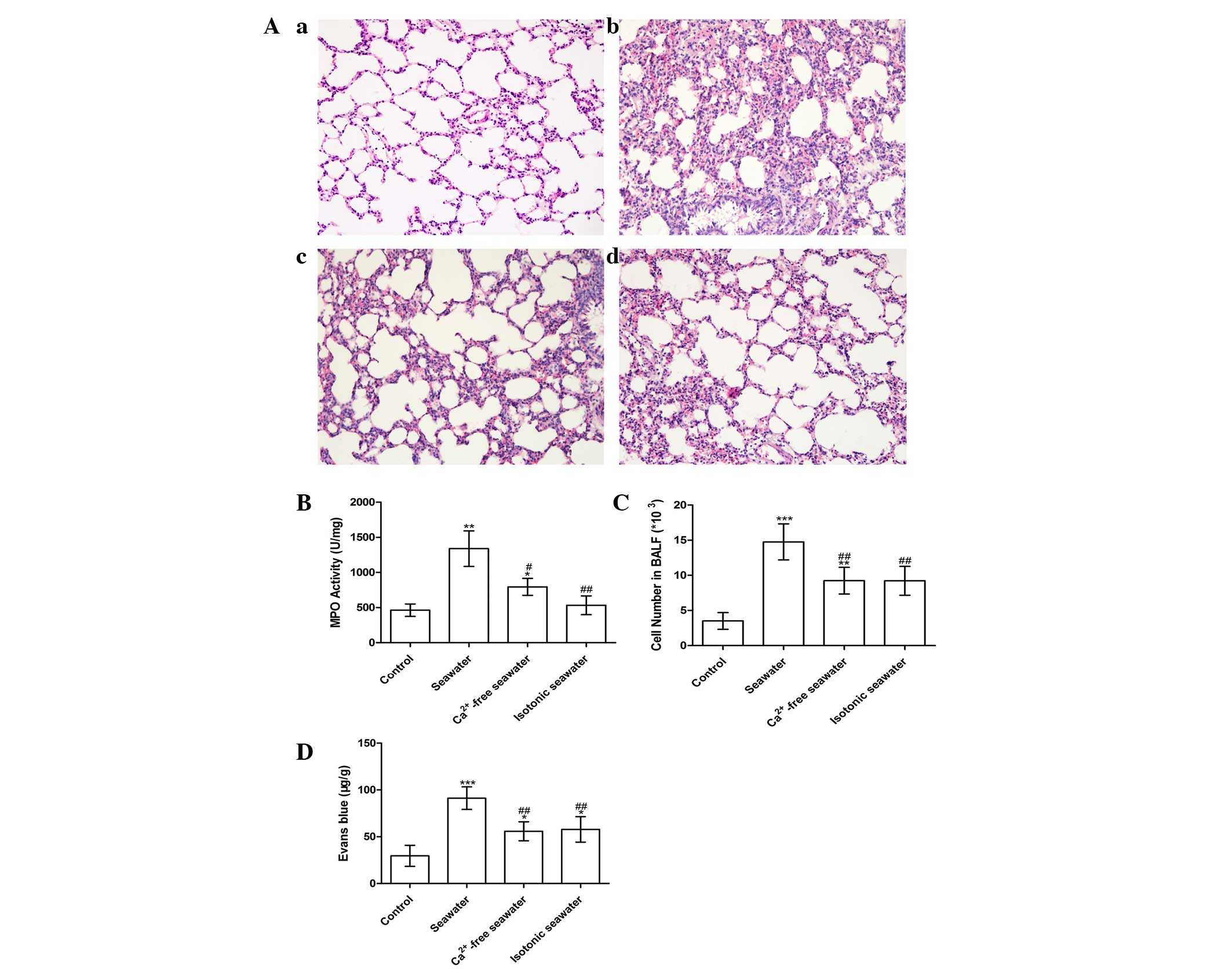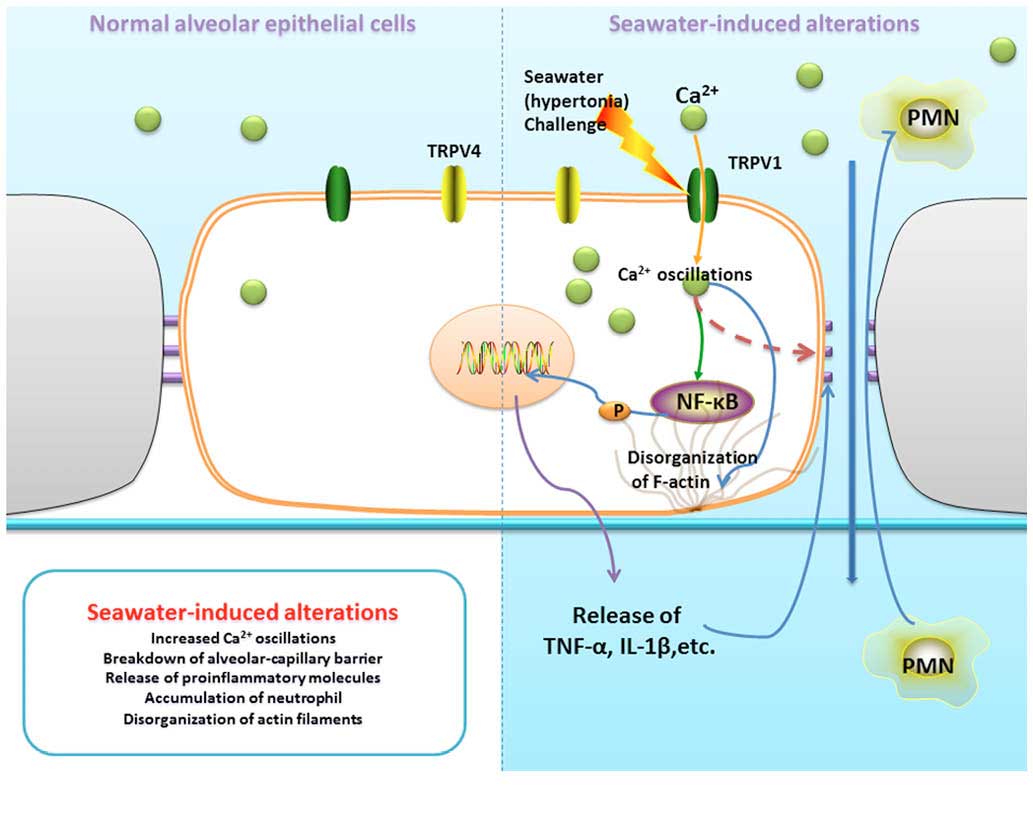|
1
|
van Beeck EF, Branche CM, Szpilman D,
Modell JH and Bierens JJ: A new definition of drowning: Towards
documentation and prevention of a global public health problem.
Bull World Health Organ. 83:853–856. 2005.PubMed/NCBI
|
|
2
|
Engel SC: Drowning episodes: Prevention
and resuscitation tips. J Fam Pract. 64:E1–E6. 2015.PubMed/NCBI
|
|
3
|
Salomez F and Vincent JL: Drowning: A
review of epidemiology, pathophysiology, treatment and prevention.
Resuscitation. 63:261–268. 2004. View Article : Google Scholar : PubMed/NCBI
|
|
4
|
Ma L, Li Y, Zhao Y, Wang Q, Nan Y, Mu D,
Li W, Sun R, Jin F and Liu X: 3,5,4′-tri-O-acetylresveratrol
ameliorates seawater exposure-induced lung injury by upregulating
connexin 43 expression in lung. Mediators Inflamm. 2013:1821322013.
View Article : Google Scholar
|
|
5
|
Li J, Xu M, Fan Q, Xie X, Zhang Y, Mu D,
Zhao P, Zhang B, Cao F, Wang Y, et al: Tanshinone IIA ameliorates
seawater exposure-induced lung injury by inhibiting aquaporins
(AQP) 1 and AQP5 expression in lung. Respir Physiol Neurobiol.
176:39–49. 2011. View Article : Google Scholar : PubMed/NCBI
|
|
6
|
Alvarez DF, King JA, Weber D, Addison E,
Liedtke W and Townsley MI: Transient receptor potential vanilloid
4-mediated disruption of the alveolar septal barrier: A novel
mechanism of acute lung injury. Circ Res. 99:988–995. 2006.
View Article : Google Scholar : PubMed/NCBI
|
|
7
|
Tauseef M, Knezevic N, Chava KR, Smith M,
Sukriti S, Gianaris N, Obukhov AG, Vogel SM, Schraufnagel DE,
Dietrich A, et al: TLR4 activation of TRPC6-dependent calcium
signaling mediates endotoxin-induced lung vascular permeability and
inflammation. J Exp Med. 209:1953–1968. 2012. View Article : Google Scholar : PubMed/NCBI
|
|
8
|
Jian MY, King JA, Al-Mehdi AB, Liedtke W
and Townsley MI: High vascular pressure-induced lung injury
requires P450 epoxygenase-dependent activation of TRPV4. Am J
Respir Cell Mol Biol. 38:386–392. 2008. View Article : Google Scholar
|
|
9
|
Pan Z, Wang Z, Yang H, Zhang F and Reinach
PS: TRPV1 activation is required for hypertonicity-stimulated
inflammatory cytokine release in human corneal epithelial cells.
Invest Ophthalmol Vis Sci. 52:485–493. 2011. View Article : Google Scholar :
|
|
10
|
Caterina MJ, Schumacher MA, Tominaga M,
Rosen TA, Levine JD and Julius D: The capsaicin receptor: a
heat-activated ion channel in the pain pathway. Nature.
389:816–824. 1997. View
Article : Google Scholar : PubMed/NCBI
|
|
11
|
Nishihara E, Hiyama TY and Noda M:
Osmosensitivity of transient receptor potential vanilloid 1 is
synergistically enhanced by distinct activating stimuli such as
temperature and protons. PLoS One. 6:e222462011. View Article : Google Scholar : PubMed/NCBI
|
|
12
|
Geppetti P, Materazzi S and Nicoletti P:
The transient receptor potential vanilloid 1: Role in airway
inflammation and disease. Eur J Pharmacol. 533:207–214. 2006.
View Article : Google Scholar : PubMed/NCBI
|
|
13
|
Sadofsky LR, Ramachandran R, Crow C, Cowen
M, Compton SJ and Morice AH: Inflammatory stimuli up-regulate
transient receptor potential vanilloid-1 expression in human
bronchial fibroblasts. Exp Lung Res. 38:75–81. 2012. View Article : Google Scholar : PubMed/NCBI
|
|
14
|
Thomas KC, Robers JK, Deering-Rice CE,
Romero EG, Dull RO, Lee J, Yost GS and Reilly CA: Contributions of
TRPV1, endovanilloids, and endoplasmic reticulum stress in lung
cell death in vitro and lung injury. Am J Physiol Lung Cell Mol
Physiol. 302:L111–L119. 2012. View Article : Google Scholar :
|
|
15
|
Hamanaka K, Jian MY, Weber DS, Alvarez DF,
Townsley MI, Al-Mehdi AB, King JA, Liedtke W and Parker JC: TRPV4
initiates the acute calcium-dependent permeability increase during
ventilator-induced lung injury in isolated mouse lungs. Am J
Physiol Lung Cell Mol Physiol. 293:L923–L932. 2007. View Article : Google Scholar : PubMed/NCBI
|
|
16
|
Liu L, Chen L, Liedtke W and Simon SA:
Changes in osmolality sensitize the response to capsaicin in
trigeminal sensory neurons. J Neurophysiol. 97:2001–2015. 2007.
View Article : Google Scholar : PubMed/NCBI
|
|
17
|
Sidhaye VK, Guler AD, Schweitzer KS,
D'Alessio F, Caterina MJ and King LS: Transient receptor potential
vanilloid 4 regulates aquaporin-5 abundance under hypotonic
conditions. Proc Natl Acad Sci USA. 103:4747–4752. 2006. View Article : Google Scholar : PubMed/NCBI
|
|
18
|
Johansen ME, Reilly CA and Yost GS: TRPV1
antagonists elevate cell surface populations of receptor protein
and exacerbate TRPV1-mediated toxicities in human lung epithelial
cells. Toxicol Sci. 89:278–286. 2006. View Article : Google Scholar
|
|
19
|
Thomas KC, Sabnis AS, Johansen ME, Lanza
DL, Moos PJ, Yost GS and Reilly CA: Transient receptor potential
vanilloid 1 agonists cause endoplasmic reticulum stress and cell
death in human lung cells. J Pharmacol Exp Ther. 321:830–838. 2007.
View Article : Google Scholar : PubMed/NCBI
|
|
20
|
Lee LY and Gu Q: Role of TRPV1 in
inflammation-induced airway hypersensitivity. Curr Opin Pharmacol.
9:243–249. 2009. View Article : Google Scholar : PubMed/NCBI
|
|
21
|
Guler AD, Lee H, Iida T, Shimizu I,
Tominaga M and Caterina M: Heat-evoked activation of the ion
channel, TRPV4. J Neurosci. 22:6408–6414. 2002.PubMed/NCBI
|
|
22
|
Liedtke W, Choe Y, Marti-Renom MA, Bell
AM, Denis CS, Sali A, Hudspeth AJ, Friedman JM and Heller S:
Vanilloid receptor-related osmotically activated channel (VR-OAC),
a candidate vertebrate osmoreceptor. Cell. 103:525–535. 2000.
View Article : Google Scholar : PubMed/NCBI
|
|
23
|
O'Neil RG and Heller S: The
mechanosensitive nature of TRPV channels. Pflugers Arch.
451:193–203. 2005. View Article : Google Scholar : PubMed/NCBI
|
|
24
|
Rosado JA, González A, Salido GM and
Pariente JA: Effects of reactive oxygen species on actin filament
polymerisation and amylase secretion in mouse pancreatic acinar
cells. Cell Signal. 14:547–556. 2002. View Article : Google Scholar : PubMed/NCBI
|
|
25
|
Ma L, Zhao Y, Li B, Wang Q, Liu X, Chen X,
Nan Y, Liang L, Chang R, Liang L, et al:
3,5,4′-Tri-O-acetylresveratrol attenuates seawater
aspiration-induced lung injury by inhibiting activation of nuclear
factor-kappa B and hypoxia-inducible factor-1α. Respir Physiol
Neurobiol. 185:608–614. 2013. View Article : Google Scholar
|
|
26
|
Fan Q, Zhao P, Li J, Xie X, Xu M, Zhang Y,
Mu D, Li W, et al: 17β-Estradiol administration attenuates seawater
aspiration-induced acute lung injury in rats. Pulm Pharmacol The.
24:673–681. 2011. View Article : Google Scholar
|
|
27
|
Ang SF, Sio SW, Moochhala SM, MacAry PA
and Bhatia M: Hydrogen sulfide upregulates cyclooxygenase-2 and
prostaglandin E metabolite in sepsis-evoked acute lung injury via
transient receptor potential vanilloid type 1 channel activation. J
Immunol. 187:4778–4787. 2011. View Article : Google Scholar : PubMed/NCBI
|
|
28
|
Cortright DN and Szallasi A: Biochemical
pharmacology of the vanilloid receptor TRPV1. An update. Eur J
Biochem. 271:1814–1819. 2004. View Article : Google Scholar : PubMed/NCBI
|
|
29
|
Reilly CA, Taylor JL, Lanza DL, Carr BA,
Crouch DJ and Yost GS: Capsaicinoids cause inflammation and
epithelial cell death through activation ofvanilloid receptors.
Toxicol Sci. 73:170–181. 2003. View Article : Google Scholar : PubMed/NCBI
|
|
30
|
Cong X, Zhang Y, Yang NY, Li J, Ding C,
Ding QW, Su QC, Mei M, Guo XH, Wu LL and Yu GY: Occludin is
required for TRPV1-modulated paracellular permeability in the
submandibular gland. J Cell Sci. 26:1109–1121. 2013. View Article : Google Scholar
|



















